| dc.contributor.author | Ribicic, Deni | |
| dc.contributor.author | Netzer, Roman | |
| dc.contributor.author | Hazen, Terry C. | |
| dc.contributor.author | Techtmann, Stephen M. | |
| dc.contributor.author | Drabløs, Finn | |
| dc.contributor.author | Brakstad, Odd Gunnar | |
| dc.date.accessioned | 2019-01-16T12:50:27Z | |
| dc.date.available | 2019-01-16T12:50:27Z | |
| dc.date.created | 2018-03-25T00:17:21Z | |
| dc.date.issued | 2018 | |
| dc.identifier.citation | Marine Pollution Bulletin. 2018, 129 (1), 370-378. | nb_NO |
| dc.identifier.issn | 0025-326X | |
| dc.identifier.uri | http://hdl.handle.net/11250/2580900 | |
| dc.description.abstract | Oil biodegradation as a weathering process has been extensively investigated over the years, especially after the Deepwater Horizon blowout. In this study, we performed microcosm experiments at 5 °C with chemically dispersed oil in non-amended seawater. We link biodegradation processes with microbial community and metagenome dynamics and explain the succession based on substrate specialization. Reconstructed genomes and 16S rRNA gene analysis revealed that Bermanella and Zhongshania were the main contributors to initial n-alkane breakdown, while subsequent abundances of Colwellia and microorganisms closely related to Porticoccaceae were involved in secondary n‑alkane breakdown and beta‑oxidation. Cycloclasticus, Porticoccaceae and Spongiiabcteraceae were associated with degradation of mono- and poly-cyclic aromatics. Successional pattern of genes coding for hydrocarbon degrading enzymes at metagenome level, and reconstructed genomic content, revealed a high differentiation of bacteria involved in hydrocarbon biodegradation. A cooperation among oil degrading microorganisms is thus needed for the complete substrate transformation. | nb_NO |
| dc.language.iso | eng | nb_NO |
| dc.publisher | Elsevier | nb_NO |
| dc.rights | Attribution-NonCommercial-NoDerivatives 4.0 Internasjonal | * |
| dc.rights.uri | http://creativecommons.org/licenses/by-nc-nd/4.0/deed.no | * |
| dc.title | Microbial community and metagenome dynamics during biodegradation of dispersed oil reveals potential key-players in cold Norwegian seawater | nb_NO |
| dc.type | Journal article | nb_NO |
| dc.type | Peer reviewed | nb_NO |
| dc.description.version | acceptedVersion | nb_NO |
| dc.subject.nsi | VDP::Miljøteknologi: 610 | nb_NO |
| dc.subject.nsi | VDP::Environmental engineering: 610 | nb_NO |
| dc.source.pagenumber | 370-378 | nb_NO |
| dc.source.volume | 129 | nb_NO |
| dc.source.journal | Marine Pollution Bulletin | nb_NO |
| dc.source.issue | 1 | nb_NO |
| dc.identifier.doi | 10.1016/j.marpolbul.2018.02.034 | |
| dc.identifier.cristin | 1575569 | |
| dc.relation.project | Norges forskningsråd: 228271 | nb_NO |
| dc.description.localcode | © 2018. This is the authors’ accepted and refereed manuscript to the article. Locked until 23.3.2020 due to copyright restrictions. This manuscript version is made available under the CC-BY-NC-ND 4.0 license http://creativecommons.org/licenses/by-nc-nd/4.0/ | nb_NO |
| cristin.unitcode | 194,65,15,0 | |
| cristin.unitname | Institutt for klinisk og molekylær medisin | |
| cristin.ispublished | true | |
| cristin.fulltext | postprint | |
| cristin.qualitycode | 1 | |

